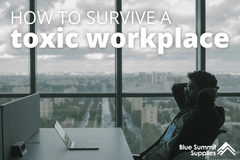It’s the year 2021. You hear the phrase ‘embracing change in the workplace.’ You burst out laughing. We get it! Why wouldn’t you? In the last year, we’ve seen a pandemic sweep the globe, every company having to spontaneously transition to working from home, and don’t get us started on how many times we’ve had to wearily tell a coworker that they’re still on mute. That should be the tagline of this year: “2021: The Year of Change (and Also You’re Still on Mute.)”
But that’s not the only kind of change we experience in the workplace. What about organizational or leadership changes? Financial changes? New technology and software, new team members, new roles – the list goes on and on.
In this article, we’ll explore the many types of changes you encounter in the workplace, understanding the reasons for change, how to communicate change (especially to employees who are resistant), and how to embrace change. So, buckle up, friends. Everything’s about to change.
Types of Change in the Workplace
It’s true that everyone will have their own definitions for types of change in the workplace but generally, you can group workplace change into five main categories:

1. Large-Scale, Company-Wide Change
This type of monumental change affects everyone in all departments of a company. An example might be a company that wants to change its organizational structure or switch the products/services they produce/offer.

2. Transformational Change
This type of change specifically targets a company’s organizational strategy and often evolves the way business itself is done. Examples include a brick-and-mortar business transitioning to e-commerce or launching a new department through restructuring.

3. Personnel Change
As the name suggests, this type of change deals with changes in employees. Examples could include hiring sprees or layoffs within the company.

4. Unplanned Change
This type of change is any kind of action that needs to be taken following unexpected events, like the CEO of a business stepping down or, uh… COVID.

5. Remedial Change
Similar to Unplanned Change, Remedial Change deals with a reaction to deficiencies or failures within a business. An example could be a shift in focus or change in leadership following poor company performance.
According to workplace leadership expert Michael Nichols, there are two speeds of workplace change: incremental and radical. Incremental is collaborative and strategic, working through all levels of the company. Instead of dropping one massive bomb on the company, incremental change works slowly and carefully, like reorganizing one department per quarter.
Radical change, on the other hand, is fast and bold, more like the bomb approach. However, radical change doesn’t always have to be negative. For example, a company’s leadership could become aware of widespread problems in the organization and take quick, decisive action to sweep through the company and fix it.

Change usually raises many questions. Why are these changes occurring? Is it the economy? Is it COVID? Does your boss constantly change his or her mind? Does your leadership lack follow-through?
There could be a million reasons why, and each reason will be dependent on the type of change and the type of industry. As an employee, it is vital that you work to understand why the change is happening. The ‘why’ will give you clarity, and clarity is important when working to understand and execute change as painlessly and efficiently as possible. Work with your leadership and your coworkers to understand what factors led to this change taking place and what your leadership imagines the outcomes will be.
Why Employees Resist Change
Let’s tackle the stickiest part of all of this: employees who resist change. Why do employees resist change? How should a manager deal with staff that is resistant to change?

Most commonly, employees resist change because they feel uncomfortable or afraid. They might fear that the change will cause them to lose their jobs, or that the change will make their working conditions so different and/or uncomfortable that they will want to quit. The fear of the unknown affects us all.
There may also be a systemic lack of trust in the workplace that ties into this fear. If employees don’t trust the decisions of leadership, it will be hard for them to get on board with any kind of change they weren’t involved in creating.
The best way to combat employees resistant to change is open and clear communication between all parties and a healthy mindset. Read on for our tips on how to approach this change head-on from both a leader and an employee point of view.
Communicating Change as a Leader
As a leader, it is not only your job to instigate change but also to communicate it effectively to those you lead. A sticky note posted on the breakroom fridge probably isn’t going to cut it. Below, we’ve compiled six tips to help you successfully communicate change to your employees.

1. Be Open and Honest
It’s important you act as transparently as possible in your communication of workplace changes. If you’re acting cagey and holding back important information from your employees, they’ll be able to tell. This could lead to a lot of gossip, resentment, and other ill will. Be honest. Why is the change occurring?

2. Cascade the Information
Basically, communicate the change from the top down. If your company is undergoing large-scale, radical change, the information should come from the president or CEO, ideally in person. Then, that person should communicate more details about the change to their direct reports, who in turn communicate it to their direct reports, and so on. See? The cascade works!

3. Explain the Desired Outcome
Your employees are going to want to know how this change will affect them, personally and professionally. Explain to them how you imagine the outcome of this change will look, emphasizing the positives but not shying away from the potential negatives, either.

4. Detail the Process
Lay out a plan of action so your employees know what’s coming and in what order. It’s natural for employees to have anxiety about the unknowns in the process, so do your best to eliminate that and shine a light on the process. This will reduce stress and anxiety.

5. Give Action Items
You’re going to need things from your employees, they know it and you know it. So be upfront about the specifics. What needs to be done? By whom? When? Target your communications at the groups of employees who need to accomplish action items for the change to take place.

6. Provide a Space for Questions and Concerns
Whether it’s a townhall-style meeting or an anonymous suggestion box, it’s important that you provide a comfortable space for employees to raise questions and concerns about the upcoming change. This will help them feel heard and less unsure about the future.
Communicating Change to Employees Template
Having a template to communicate change to your employees can make the whole process seem less daunting. Below is a template from PostGrid you can use to communicate any kind of change to your employees through email:
(Company name)
(Apartment or unit number, street address)
(State, ZIP code)
Date: ___ (date on which the letter was drafted)
Subject: New Policy/Policy Change Notification
Dear Employee(s),
We wish to announce some changes that have been made to our company policies.
OR
We wish to announce a new policy, effective from (date from when the policy shall be effective.) The changes are listed below: OR The new policy states that:
(Mention the required details in brief)
We hope that all the changes shall be adhered to by every employee, and everyone will help make the new system successful. We apologize for any inconvenience. Please feel free to reach out to (designated support person) with any questions or concerns.
Thank you for your continued support.
Sincerely,
(Your name)
(Your designation in the company)
Feel free to take this template and personalize it or adjust it to fit your needs!
Embracing Change at Work as an Employee
Now let’s look at this from the point of view of the employee, not the leader. Facing change in the workplace is hard. We all know it. But we have some tips to help you get through the change and even begin to embrace it.


Practice Empathy
If you feel like the change being made doesn’t affect you at all or, worse, affects you negatively, it can be easy to start casting blame. We know this can be difficult but try to avoid the blame game. Instead, practice empathy for those that the change does affect or affects positively. There is a reason this change was put in place and the sooner you can find some peace about that, the sooner you’ll be able to move on.

Understand Why
As mentioned earlier, make it your mission to understand why this change is taking place. If the reason isn’t immediately obvious, try talking to your manager or an HR representative. Few company shake-ups happen for absolutely no reason, so do your best to get some clarity so you can move forward with open eyes.

What’s in Your Control?
There’s a pithy little adage about accepting things beyond our control: ‘may I have the courage to change the things I can change, the patience to accept the things I cannot change, and the wisdom to know the difference.’ It might sound trite, but there really is a nugget of wisdom in there. Identify what about this situation is in your control, what isn’t, and begin to adjust your mindset accordingly.

Find the Positive
Recognize why change is a good thing! By this, we mean change in general or the specific change you’re facing now. A company’s ability to change goes hand in hand with its ability to grow and succeed, which definitely benefits you as an employee. Additionally, flexible management is healthier than stagnant management and employers that welcome change are more welcoming and primed for innovation. These are all markers of a healthy workplace, so focus on the positives!
To sum it up, change is messy but inevitable. And, in fact, change is necessary for a healthy company to keep up with the changing work. Not to mention, change is everywhere you look if you happen to live in the post-COVID world. But whether you’re the leader instigating the change or the employee feeling the effects of it, there is clear path forward to healthy growth and innovation for all.
Do you love office talk as much as we do? Follow our office supplies blog for the latest office trends, team building strategies, product comparisons, and more.
If you have any questions or want to talk to someone about office supplies, send us an email or connect with us on Twitter, Facebook, or Instagram.
 For more informative articles about office supplies, subscribe to our email newsletter!
For more informative articles about office supplies, subscribe to our email newsletter!
Never fear, you won't begin receiving daily sales emails that belong in a spam folder. Instead, we promise a fun weekly roundup of our latest blog posts and great finds from across the web. And if you lose interest, it's always easy to unsubscribe with a single click.









